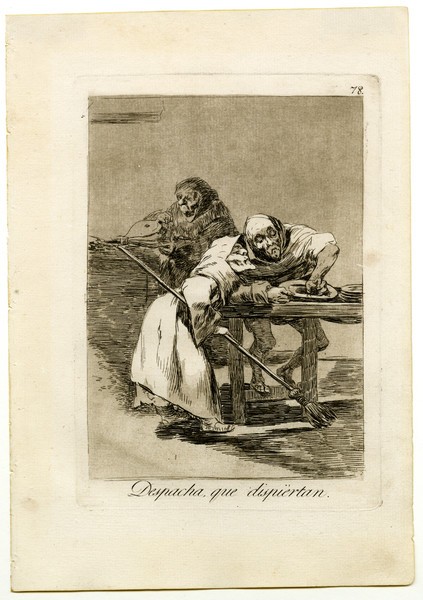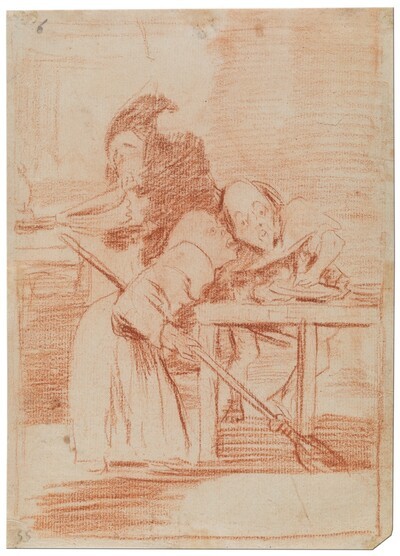- Cronología
- Ca. 1797 - 1799
- Dimensiones
- 218 x 152 mm
- Técnica y soporte
- Etching and burnished aquatint
- Reconocimiento de la autoría de Goya
- Undisputed work
- Ficha: realización/revisión
- 16 Jan 2011 / 29 May 2024
- Inventario
- 225
Despacha, que dispiértan. (at the bottom)
78. (in the upper right-hand corner)
See Francisco de Goya y Lucientes, Painter.
A single state proof prior to the additional burnishing is preserved in the Prado Museum, in which the handwritten title can be read with the word "Despacha" crossed out and corrected underneath in careful calligraphy.
The preparatory drawing for this engraving is in the Prado Museum.
Three monks are concentrating on various domestic tasks. In the foreground, one is cleaning a plate under the watchful eye of another, who is in profile and holding a broom, perhaps whispering the title of the print in his ear. In the background, another figure is stoking the fire with a bellows.
The figures have been described by means of parallel lines executed with etching. He then applied a fine-grained aquatint to achieve a medium tone that creates an intimate atmosphere in the scene.
The commentary in the Prado manuscript identifies them as goblins: "The little goblins are the most industrious and helpful people that can be found: as long as the maid keeps them happy, they stir the pot, cook the vegetables, scrub, sweep and quiet the child; it has been much disputed whether they are devils or not; let us be disabused, devils are those who are busy doing evil, or hindering others from doing good, or doing nothing at all". The manuscript in the National Library comments: "The friars have their meals alone at night with the nuns; they wash the dishes and they blow the fire", and Ayala's notes: "The friars and nuns have night parties to sing well during the day".
There are several engravings in the series of The Caprices in which Goya censures certain attitudes of members of the Church, especially the monks, who were also known as goblins (no. 49, Goblins, and no. 79, No One Has Seen Us). In this case he satirizes the detached life they led, with no other concerns than to devote themselves to domestic chores after having satisfied their carnal appetites.
The plate is in rather poor condition preserved (National Chalcography, no. 249).
-
Goya. Gemälde Zeichnungen. Graphik. TapisserienKunsthalle BaselBasle1953from January 23th to April 12th 1953cat. 256
-
Goya. La década de Los CaprichosMadrid1992organized by Real Academia de Bellas Artes de San Fernando sponsored by Fundación Central Hispano, Madrid, consultant editor Nigel Glendinnig. From October 26th 1992 to January 10th 1993cat. 182
-
Francisco de GoyaMuseo d'Arte ModernaLugano1996exhibition celebrated from September 22nd to November 17th.cat. 78, p.105
-
Francisco Goya. Sein leben im spiegel der graphik. Fuendetodos 1746-1828 Bordeaux. 1746-1996Galerie KornfeldBern1996from November 21st 1996 to January 1997cat. 84
-
Francisco Goya. Capricci, follie e disastri della guerraSan Donato Milanese2000Opere grafiche della Fondazione Antonio Mazzottap.50, cat. 78
-
Goya e la tradizione italianaFondazione Magnani RoccaMamiano di Traversetolo (Parma)2006consultant editors Fred Licht and Simona Tosini Pizzetti. From September 9th to December 3th 2006cat. 78, p.165
-
Goya. Opera graficaPinacoteca del Castello di San GiorgioLegnano2006exhibition celebrated from December 16th 2006 to April 1st 2007p.44
-
Goya et la modernitéPinacothèque de ParisParís2013from October 11st 2013 to March 16th 2014cat.11
-
Goya engravings and lithographs, vol. I y II.OxfordBruno Cassirer1964p.156, cat. 113
-
Vie et ouvre de Francisco de GoyaParísOffice du livre1970p.185, cat. 609
-
Goya, la década de los caprichos: dibujos y aguafuertesMadridReal Academia de Bellas Artes de San Fernando1992pp.300-302, cat. 182-183
-
Catálogo de las estampas de Goya en la Biblioteca NacionalMadridMinisterio de Educación y Cultura, Biblioteca Nacional1996p.115, cat. 170
-
El libro de los caprichos: dos siglos de interpretaciones (1799-1999). Catálogo de los dibujos, pruebas de estado, láminas de cobre y estampas de la primera ediciónMadridMuseo Nacional del Prado1999pp.384-387
-
ParísPinacoteca de París2013p. 69
-
Goya. In the Norton Simon MuseumPasadenaNorton Simon Museum2016pp. 42-75

